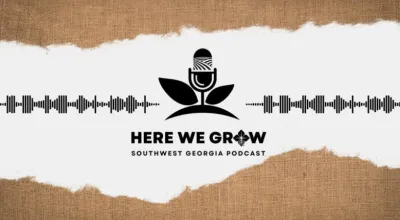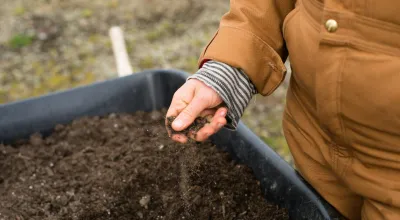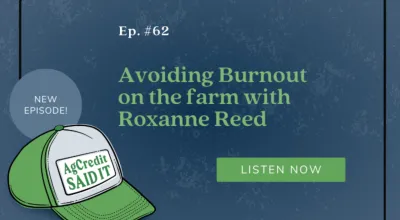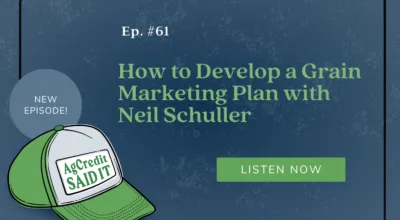
Episode 70: Looking at Financials Beyond the Balance Sheet with Nathan Buzard
As year end approaches, we know it’s time to start updating our balance sheets. The balance sheet gives a great snapshot of your operation, but when our loan team is looking at your financials, what else are they considering in the overall analysis? There are several other factors that come into play. In this episode, AgCredit Credit Analyst Nathan Buzard shares other key factors he's looking at when completing a loan analysis. Let’s take a look at the other key factors:
- The 5 Cs of Credit:
- Character – ownership structure, parties involved.
- Capital – owner equity, working capital and overall financial wherewithal.
- Capacity – repayment ratios.
- Collateral – security and its valuation.
- Conditions of Approval – are there any special conditions to the operation and/or the approval, such as terms?
- Management Experience and Reputation.
- Long-term Sustainability and Market Volatility.
- Business Plans and Projections.
- Credit History.
- Conservation Programs.
- Succession Plans and Generational Transfer.
All of these items together help the AgCredit team understand the full circle of your operation, enabling them to tailor the right loan products and terms that fit your needs.
- Transcription
Speaker 1 (00:08):Welcome to AgCredit Said It, your go-to podcast for insights on farm finance and maximizing your return on investment. Join us as we talk to industry leaders, financial experts, and area farmers, bringing you skillful advice and strategies to grow your farm's financial future ag credit setting where farm finance goes beyond the balance sheet.
Matt Adams (00:39):Hey everyone, and welcome back to another episode of AgCredit Said It. Today we're taking you beyond the balance sheet and talking about what other factors go into analysis for a loan. Our guest expert is Nathan Buzard credit analyst for AgCredit. Welcome Nathan. Glad to have you on, sir.
Nathan Buzard (00:56):Great to be with you today, Matt.
Matt Adams (00:58):So Nathan is one of our credit analysts, another key player in the ag credit team. So Nathan, we got a lot of stuff to go over in this episode, so let's dive right into it. So we look at focusing beyond the balance sheet, and this all lot goes back to what we're really pushing to our listeners is that how to best grow your operation, the best return on investment. And when we look at financials and where we're sitting, where that operation is financially, that's a big part. So besides a balance sheet, what are the most important things you're looking for when doing loan analysis?
Nathan Buzard (01:40):A good way to look at this is to think about the structure that we ourselves in the lending world tend to think through this process, the thought process of underwriting loans. So, what comes to mind there is the five Cs of credit. Some listeners may have heard of that before but thought we'd just kind of list down through those five Cs of credit and a short explanation of those. Number one's, the character and management aspect of the credit. Second one's capital, and that's your balance sheet essentially. The third. Number three is a capacity, repayment capacity, aka earnings, and the fourth C is collateral. And the fifth C finally is a condition of approval of the loan, kind of the structuring of the loan and who's signing on that. So, jumping back up to character and management, we are looking at the lending history with that credit and other lenders, maybe the reputation in the community of the borrower or applicant and are they amicable enough to work with operational and strategic details of the operation, risk management, grain marketing, estate planning, what are their plans going into the future?
(03:05):So all that's wrapped up in that character and management. Again, with capital, as I said, that's your balance sheet and things like working capital and net worth and owner equity and some of those measures that we keep track of and use as underwriting standards, but that's all your balance sheet and financial position capacity. We spend a good bit of time on that as credit analysts. That's the ability to repay the loans through regular earnings and to meet all the other obligations. So we're an earnings based lender, so that's what we focus on. We don't want to make loans that can't be paid through normal operating earnings. So that's where a lot of our focus and a lot of our questions that we might put out to the loan officers and ultimately to the applicants. A lot of those focus around that earnings discussion. So then finally, collateral.
(04:04):Again, we're not a security-based lender as some lenders are, so we take collateral to help secure the loan, but most of our focus again is back on the capacity and earnings there and the security, the collateral that's just being good stewards of the co-op’s resources. If all else fails from an earnings and ability to repay standpoint, the security just helps protect the capital of the co-op. And then finally again, the conditions of approval that's signing. On the note, are there any guarantors? Do we need a loan guarantee? Most typically from farm service agency just to help support that loan documentation of assets, loan covenants, limitations on capital expenditures. Sometimes you get into on larger operating lines of credit. So that's all part of those conditions of approval.
Matt Adams (05:07):No, that's great. Nathan, one thing I'll touch base on there too with what our credit analyst team has always drove in my mind too is the information that we provide to our credit analyst team, the analysis is only as good as the quality of information that we give you guys. So the more detailed we can be and the more detailed our members can give us information, the better job we can do for that member. And really, I always say we can maybe see some things that have been overlooked or some different trends that we just might not see without providing those good numbers. You always say as an account officer and a lending manager, especially account officer, we may have some crazy ideas. Sometimes we give it to our CAs to make our dreams come true for our members. So you guys are really the backbone to when we start providing the services we do to our members.
Nathan Buzard (06:08):Definitely a team effort and a lot of these operations just get more and more complex. So takes a team to sort it all out
Matt Adams (06:17):That is sure. So what are some things that people don't realize as part of a loan analysis?
Nathan Buzard (06:24):There's kind of a pot things that we could probably mention there. We pull credit reports just like if you're going out to finance a car at the dealership. So credit reports are top of mind courthouse searches where we go to the courthouse and determine what properties are recorded, the courthouse does that reconcile what the balance sheet secretary of state UCC search to look at liens that are out there on shadows and things like that. So just kind of helping to put that balance sheet together through those searches. For some types of businesses, we may refer, look up their website, maybe it's like a retail facing business that's part of this application and we're trying to understand it better. So we may go on the internet and pull up the website of that business for example. Again, we focus a lot on the earnings and the projection on these medium and larger lending relationships. So we might be using a borrower's projections that they've given us or formulating our own and checking with the borrower. Does this make sense? Are we on the right track here? So even livestock operations in terms of cattle or dairy, we could even get into monthly cash flows to assess is the operating loan of the right size for what they're doing out there.
(08:00):We look at trends quite a bit, especially after multiple years with that borrower. We can build up a nice set of trends there with the balance sheets and earnings and usually there's an explanation for the ups and downs and we kind of challenge ourselves to make sure we understand that.
Matt Adams (08:20):Yeah, it always seems like the numbers never lie and especially we look at just the ever, I want to say the ever-evolving environment that we are at in agriculture. The trends that get to be a pretty significant part of when we start looking at especially our long-term lending with our members. I think.
Nathan Buzard (08:44):Yeah, it sure does. It sure does. After a few positive years, it's fun to look at those trends. And then of course the pendulum swings and agriculture.
Matt Adams (08:54):Right.
Nathan Buzard (08:56):But that's all right.
Matt Adams (08:58):So Nathan, you were talking about the five Cs and one of those was character. How important is the borrower's management experience and that reputation within the farming community?
Nathan Buzard (09:09):Yeah, yep. That's definitely always important to us and it becomes even more important as that lending relationship grows and the relative leverage might increase as well. So the management experience, some borrowers might appear to be jumping into a new venture, but once we learn more about their background, we come to understand, oh, that they've got maybe a lot of years doing this thing that appears to be a new venture to us. So it's just that dialogue that goes along with having a good relationship between the applicant, the borrower, and the loan officers and ag credits.
Matt Adams (09:50):And when we look at that character, I think one thing I look at too, especially in the area I cover where we have a lot of younger producers that we've brought on our beginning farmers where that character may not be, they're young, there's not much background, there's not much management experience, and you guys take that into consideration and we do as a lending team and we can hopefully help give the information to develop that member into being an exceptional manager on his farm and building that character for him.
Nathan Buzard (10:23):That's right. And even finding out they have a mentor or about they're working on finding a mentor, things like that can be really valuable for those young beginning operators.
Matt Adams (10:35):So Nathan, do you evaluate the long-term sustainability of a farms operations and what indicators do you look for?
Nathan Buzard (10:43):Yeah, we certainly do. If it was a case where you knew you were just making one tractor loan to an operation and maybe that's the only loan you ever make to 'em, we wouldn't spend as much time on it perhaps. But yeah, especially long-term loans or operating loans, they're kind of two opposite ends of the spectrum you would think. But once we get into an operating relationship, we intend for that to last many years. So yeah, we're looking at that long-term sustainability. Things that we look for in that regard is certainly the past and present profitability. The earnings related to their obligations is
(11:29):Kind of first and foremost. But in that context, we also want to recognize sometimes there's changes that have just occurred or about to occur with an operation. It might be a big management change, maybe an uncle's getting bought out or retiring and now it's going to be like a father son operation and maybe the son brings some experience and education all of a sudden to the operation. And those are things that can be positives a lot of times when we learn a little bit more about what's going out there, things you can't see just by looking at a balance sheet or credit report or something like that. So additional things looking out, are they able to replace depreciating assets and also make those tiling upgrades or on-farm storage, let's say for a grain farm operation, their ability to keep up with the times, so to speak, or replace those depreciating assets that have enabled them to make money in the past, those things still wear out, whether it may be an integrator barn, things like that as well. Where are they at in the life cycle of some of those big ticket items and what are their capital needs in the next few years? Might not make sense to buy that big farm when there's still things to take care of on the depreciable asset side.
Matt Adams (12:56):Right. So Nathan, not that the ag markets ever have any volatility in them at all, and I'm just saying that with a smile on my face here, but we are in there again, every evolving market and we have seen quite a bit of volatility here lately within our markets. From your position, how do you assess a farm's ability to handle that market volatility? We look at price fluctuations and commodities or look at our weather that we've had here at the last, I even go 24 months on. I feel the weather patterns are a little different than what we were experiencing even maybe 10 years ago. So there's a lot of different factors to go into stuff now.
Nathan Buzard (13:39):There certainly are. There certainly are. And the same breadth. There's a lot of tools out there too to help kind of mitigate a lot of that. And maybe that's half the work is just sorting through all the options that are out there and deciding what makes sense for your own operation. When you think about the volatility and risk with commodities and weather, the big one thing we start off with is just looking at again, the capital position, that balance sheet. And if they don't have many debts, they've got a whole lot of assets, they can weather through a lot of ups and downs and not have to be so reactive in their decision making either. Whereas somebody who's quite leveraged and everything has to go right or at least average or better for all the puzzle pieces to fit there, we got to look really close. What are they doing to mitigate risk? So things we look at, of course, thinking of a grain farm crop insurance comes right to mind, do they have it? What levels of coverage? Things like that. And that's hand in with grain marketing as well. Do they have a grain marketing plan? What will they tell you when you ask about grain marketing?
(15:03):Are they consistent sellers just selling a little bit each month? Are they swinging for the fences, trying to time the market an awful lot and then are they consistent or not in whatever their approach is? But we've kind of seen that happen too, where they totally flipped their strategy from one year to the next and if they would've just kept with the strategy that didn't work that great the first year, it would've worked really well the second year. But you know what I'm saying, they're kind of flipping strategies around and
Matt Adams (15:39):Oh yeah,
Nathan Buzard (15:40):Makes it tough.
Matt Adams (15:41):It's one of those as farmers, we're the eternal optimists. So we're always shooting for the fences, I guess we're always thinking the grass is going to be greener, the sun's going to be a little shinier next year, and that's what we're always banking on. But that's one place where I feel that we as a lending team come in, we talk about these trends in this long-term stuff and how you guys look at stuff, Nathan, that, like you said, we're not just making a one-off loan here. We're not looking at something a one-off and hey, you're out the door and we're not cashing carry. We're looking at this on a long term. We want this operation to grow from this generation and the next generation on this. And I think one thing that when I go back to even my beginning of farmers, when you're looking to do business with somebody, look for that. You don't want to have just a one and done type of lender. You want somebody that's going to, I always say we want to be a tool for that operation. We don't want to be the, oh, it's my banker as they call us, bankers calling us, say it's like, Hey, you know what? I got something on my mind. I'm going to give Nathan a call and run this past him. I'm going to give Matt a call. Let's shake down these numbers. Let's see what this looks like before I do anything.
Nathan Buzard (16:55):That's right, yeah. And any anecdotal things that we might mention on this podcast here, that's just one ingredient in the big stew that makes up that credit decision. So yeah, there's strengths and weaknesses and you just decide where you're at when you put it all together there.
Matt Adams (17:16):Definitely. So going onto the next question here, I always like to think that we are the only lender out there, but there are a lot of options out there that producers have. So what role does a borrower's credit history and relationship with other lenders play in the decision making process? Nathan?
Nathan Buzard (17:34):Yeah, definitely. Again, this is kind of in that character and management of the five Cs. So plays a significant role. Now on one hand, we don't want to jump to conclusions by any means when we're looking at credit histories such, but it does play a real role thinking about a credit report, a credit bureau report. There could be explainable reasons for some past dings that show up on the report, medical bills or a temporary loss of a job, a big recession, inadequate service from their other lender or terms that weren't right for their cash flow. So there's reasons for things that might show up in a credit history, but we start to see a lot of late pays and tax liens, collections, multiple credit cards come to mind. These are all things that'll start to trigger some questions for us. Certainly financing of what we call high dollar consumer related items, big campers and boats.
(18:44):And this stuff costs a lot of money anymore, so it doesn't take too many of those loans to really weigh down your cashflow sometimes. So those are all things that could trigger some questions or sort of flavor the package a little bit. One other thing I definitely wanted to mention was split credit. We really don't like to have multiple operating lenders out there. It's a little bit like insurance maybe you might say, with ensuring your automobiles under one carrier and your house under another and it just isn't good when there would be a claim on the property there. And so
Matt Adams (19:25):Anyhow,
Nathan Buzard (19:25):It's a little bit similar with your operating financing and term loans to some extent too, that if you got one loan but you got 50 different lenders out there, that's a little different than having just two or three primary lenders out there.
Matt Adams (19:46):Oh, definitely. One thing, Nathan, that I think is really kind of farmers have always been a conservationist. We've always tried to take care of our land. I think it's become a bigger play in the last couple years, especially with a lot of the push for the different programs and stuff that's out there now for our producers to use. So can you take that a little further? Can you explain how do you factor in the farm's environmental practices or their participation in the conservation programs when we're assessing risk?
Nathan Buzard (20:20):Yeah, first on the negative side if you will, is it is very helpful to go out there. We want to assess are they doing things that are bad, not good stewardship of the resources or their own assets even so if we go out there on a farm visit and there's kind of weeds everywhere and their main equipment lineup is out in those weeds somewhere, structures are falling down and that kind of thing, that's a bit of a concern honestly for a lot of lenders. So there's that on the negative side. But on the positive side, in terms of building up and maintaining soil health and minimum till and conservation practices like that and keeping our waterways clean, there's a big push from the top down. Even a lot of resources available out there now to try some of those approaches and encourage a little more stewardship towards our natural resources. So generally, I mean, we'd be very positive towards seeing that. Certainly I think it deserves a conversation what the borrower to understand where they're at in that process because something like switching over to full, no-till and cover crop usage and all that, it can take many, many years to
(21:54):Bear fruit from that investment. So it's valuable for us to know, hey, two years ago I started doing this on half my acreage and it helps explain too. Maybe you need a little different equipment lineup and things like that. So yeah, we would like to hear all about that.
Matt Adams (22:18):So Nathan, we, we talked before about we're relationship lenders, we want to see long-term relationships. How important is a farmer's business plan in that future growth projections when you're deciding on the loan?
Nathan Buzard (22:36):Yeah, it can be very important, and again, this is kind of in that character and management of the five Cs, but do they plan to be an ongoing operation or is this more of a, there's a retirement coming up sometime down the road or maybe in the nearby and they're just looking to wind down the operation. Neither one's right or wrong. It just helps us understand what their intentions are and maybe what their needs are in the future. So does our loan request fit into that plan? If they're retiring in three years, does it make sense that they want to buy another farm today? Or maybe it does, but just is it making sense for their plan if it's an ongoing and or growing operation? Again, we're going to go back to their projections for the short term. Does it make sense what they're doing out there?
(23:34):Maybe they're adding another 30% increase in their acres farmed next year. So are we as a lender keeping up with their needs from an operating standpoint and things like that. So just knowing what their plans are can help us walk with that operation in terms of keeping up with their needs. Sometimes they're getting into a whole new venture, and we need to maybe lean on that applicant or the borrower quite a bit with, give us your projection and show us how is this going to work out and what are all your assumptions that you're using to come up with those projections and heavily consider that when we're assessing the repayment ability there.
Matt Adams (24:21):Oh, definitely. It's one of those help us help you. You tell us, we will ask the right questions and we will help you make that best decision. Sometimes it may not. I always tell guys, sometimes it may not be the decision you were even thinking about, but that's where we come in with this information to help that operation.
Nathan Buzard (24:40):Exactly. Yeah. I'd be remiss if I didn't mention on those retiring farmers. There's a big push through, I think state and federal resources to try to help with that handoff from retiring established farmers to young and beginning farmers in terms of equipment, sales plans that help mitigate taxes for that retiring farmer. So a lot of resources out there now more than ever it seems like to help those retiring farmers. So again, that helps us as a lender to know what their plans are, and we can maybe provide some of those resources or links thereof.
Matt Adams (25:24):Definitely. So Nathan, I think one of the big challenges that agriculture sees today is going away from your traditional just grain farm where we have a lot of different other, we call off-farm income streams for diversification for our operations to grow. And how do you evaluate that borrower's off-farm income in diversification efforts and does that affect their credit worthiness?
Nathan Buzard (25:53):Good question. Yes. We definitely look at the off-farm income situation of our applicants. We generally just look at things in a, you might say, a consolidation approach where we look at the farm, any non-farm businesses, they own any wages they might have in that household. So we just kind of put it all together. It's all kind of equally weighted, you might say, dollar for dollar. So yeah, the off-farm income can be a very significant positive aspect of that repayment capacity that we're trying to model up. So some of our territories within our association area, that's a big thing that hits the earnings in a positive way. Also, health insurance is provided by an employer. That can be a substantial factor in lowering the family living expenses for that household, so to speak, that otherwise have to be paid for.
Matt Adams (26:59):Yeah, I think that's a big part, especially when we look at in today's environment where cost of living is just higher than it was a few years ago, and do we have that off farm income? Is it kind of easing the pressure off that farm to keep more money in the farm? I guess we want to say.
Nathan Buzard (27:17):Yeah, that's exactly right. Yeah, and we didn't talk a whole lot about family living expense, but that's something we try to size up for each of our applicants when we have a household or individuals applying for a loan is kind of what their family living expenses are, and we kind of treat that as another line-item expense essentially that needs to be covered. We all have to eat and go home at night. So there's an expense to that and we try to factor that in. But when there's that off-farm wage or off-farm business, sometimes that really helps to cover that and leaves the farm a little free and clear just to cover its own expenses.
Matt Adams (28:01):Definitely we as farmers feed the world, but we also have to put down on paper how much it's going to cost to feed ourselves too, so we have all those projections in line.
Nathan Buzard (28:10):That's right.
Matt Adams (28:11):So Nathan, this is going back that little further from one of our previous questions. We talked about that farm business plan, talking about a farms succession plan that you touched base on a little bit. What impact does that succession plan or the generational transfer strategy have on that loan decision? If you want to just dive in a little deeper on that.
Nathan Buzard (28:33):Yeah, especially as our lending relationship gets bigger with a given borrower, it becomes more and more important to have those discussions and understand what the plan or lack thereof is for that borrower. So yeah, it's very important, especially when there's a next generation involved in that farm, and this is intending to be an ongoing business concerned onto the next generation. As a lender, we want to be right there with them when that handoff of the baton occurs, so to speak. And if they can have a good succession plan and estate plan in place, that's going to make it go all the more smoother. Certainly sometimes there's other siblings that are not involved in the farm operation, but they need to be perhaps part of the plan too. And so the sooner our borrowers can sort all that out, and sometimes we're doing loans to help enable those plans to be executed, maybe there is a buyout that needs to occur, for example, and we do those buyout loans to help with that succession.
(29:46):So it's really important, helps the estate planning. It helps to ensure the operations continue as smoothly as possible while managing those tax liabilities. Frankly, it just seems like it keeps that much more wealth in the rural areas where a lot of us live and work. So there's a lot to say for that and it kind of helps just those discussions of estate planning when there's a next generation coming in, it should help give that next generation more ownership and buy-in or agency as to what's going on on that farm operation and instead of waiting until they're 60 years old themselves and then the estate succession planning comes up at that point.
Matt Adams (30:38):Well, Nathan, I want to thank you again for joining us. We appreciate you sharing your knowledge with our listeners today and just want to definitely send out back to all of our listeners and our members out there that we look at this. We are truly a lending team behind our members to help make that decision and help hopefully be a tool to that operation to grow, not only for now, but in the future.
Nathan Buzard (31:01):Well, thanks Matt. It's been nice to be with you today. And yep, it takes a team and that includes the borrowers themselves, kind of part of the teams. So hopefully somebody gained a lot out of this conversation.
Matt Adams (31:16):You are a hundred percent right there, Nathan. If you haven't already, be sure to subscribe to Ag Credit, set it on your favorite podcast app like Apple Podcast, Spotify, or iHeart so you never miss an episode. We'll talk to you next time on AgCredit Said It.
Speaker 1 (31:38):Thank you for listening to AgCredit Said It. Be sure to subscribe in your favorite podcast app or join us through our website at agcredit.net so you never miss an episode.

























